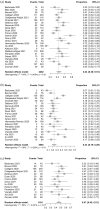Effectiveness of the use of a high-flow nasal cannula to treat COVID-19 patients and risk factors for failure: a meta-analysis
- PMID: 35467449
- PMCID: PMC9047804
- DOI: 10.1177/17534666221091931
Effectiveness of the use of a high-flow nasal cannula to treat COVID-19 patients and risk factors for failure: a meta-analysis
Abstract
Background: Coronavirus disease 2019 (COVID-19) has spread globally, and many patients with severe cases have received oxygen therapy through a high-flow nasal cannula (HFNC).
Objectives: We assessed the efficacy of HFNC for treating patients with COVID-19 and risk factors for HFNC failure.
Methods: We searched PubMed, Embase, and the Cochrane Central Register of randomized controlled trials (RCTs) and observational studies of HFNC in patients with COVID-19 published in English from January 1st, 2020 to August 15th, 2021. The primary aim was to assess intubation, mortality, and failure rates in COVID-19 patients supported by HFNC. Secondary aims were to compare HFNC success and failure groups and to describe the risk factors for HFNC failure.
Results: A total of 25 studies fulfilled selection criteria and included 2851 patients. The intubation, mortality, and failure rates were 0.44 (95% confidence interval (CI): 0.38-0.51, I2 = 84%), 0.23 (95% CI: 0.19-0.29, I2 = 88%), and 0.47 (95% CI: 0.42-0.51, I2 = 56%), respectively. Compared to the success group, age, body mass index (BMI), Sequential Organ Failure Assessment (SOFA) score, Acute Physiology and Chronic Health Evaluation (APACHE) II score, D-dimer, lactate, heart rate, and respiratory rate were higher and PaO2, PaO2/FiO2, ROX index (the ratio of SpO2/FiO2 to respiratory rate), ROX index after the initiation of HFNC, and duration of HFNC were lower in the failure group (all Ps < 0.05). There were also more smokers and more comorbidities in the failure group (all Ps < 0.05). Pooled odds ratios (ORs) revealed that older age (OR: 1.04, 95% CI: 1.01-1.07, P = 0.02, I2 = 88%), a higher white blood cell (WBC) count (OR: 1.06, 95% CI: 1.01-1.12, P = 0.02, I2 = 0%), a higher heart rate (OR: 1.42, 95% CI: 1.15-1.76, P < 0.01, I2 = 0%), and a lower ROX index(OR: 0.61, 95% CI: 0.39-0.95, P = 0.03, I2 = 93%) after the initiation of HFNC were all significant risk factors for HFNC failure.
Conclusions: HFNC is an effective way of providing respiratory support in the treatment of COVID-19 patients. Older age, a higher WBC count, a higher heart rate, and a lower ROX index after the initiation of HFNC are associated with an increased risk of HFNC failure.
Keywords: COVID-19; ROX index; age; high-flow nasal cannula; risk factor.
Conflict of interest statement
Figures




Similar articles
-
[Value of modified ROX index in predicting the outcome of patients with acute respiratory distress syndrome due to SARS-CoV-2 infection treated with high-flow nasal cannula oxygen therapy].Zhonghua Wei Zhong Bing Ji Jiu Yi Xue. 2024 Jun;36(6):585-590. doi: 10.3760/cma.j.cn121430-20240228-00171. Zhonghua Wei Zhong Bing Ji Jiu Yi Xue. 2024. PMID: 38991956 Chinese.
-
Comparison of ROX index (SpO2/FIO2 ratio/respiratory rate) with a modified dynamic index incorporating PaO2/FIO2 ratio and heart rate to predict high flow nasal cannula outcomes among patients with acute respiratory failure: a single centre retrospective study.BMC Pulm Med. 2022 Sep 16;22(1):350. doi: 10.1186/s12890-022-02121-9. BMC Pulm Med. 2022. PMID: 36114516 Free PMC article.
-
ROX index and SpO2/FiO2 ratio for predicting high-flow nasal cannula failure in hypoxemic COVID-19 patients: A multicenter retrospective study.PLoS One. 2022 May 12;17(5):e0268431. doi: 10.1371/journal.pone.0268431. eCollection 2022. PLoS One. 2022. PMID: 35551328 Free PMC article.
-
Comparison between high-flow nasal cannula and conventional oxygen therapy in COVID-19 patients: a systematic review and meta-analysis.Ther Adv Respir Dis. 2024 Jan-Dec;18:17534666231225323. doi: 10.1177/17534666231225323. Ther Adv Respir Dis. 2024. PMID: 38230522 Free PMC article.
-
Comparison between high-flow nasal cannula and noninvasive ventilation in COVID-19 patients: a systematic review and meta-analysis.Ther Adv Respir Dis. 2022 Jan-Dec;16:17534666221113663. doi: 10.1177/17534666221113663. Ther Adv Respir Dis. 2022. PMID: 35861299 Free PMC article.
Cited by
-
High-Flow Nasal Cannula in COVID-19 Patients With Moderate to Severe Respiratory Distress: A Retrospective Analysis.Cureus. 2024 Jan 18;16(1):e52518. doi: 10.7759/cureus.52518. eCollection 2024 Jan. Cureus. 2024. PMID: 38371128 Free PMC article.
-
Serial biomarker measurements may be helpful to predict the successful application of high flow nasal cannula in COVID-19 pneumonia patients.Sci Rep. 2025 Jan 4;15(1):756. doi: 10.1038/s41598-025-85210-z. Sci Rep. 2025. PMID: 39755869 Free PMC article.
-
Delayed intubation associated with in-hospital mortality in patients with COVID-19 respiratory failure who fail heated and humified high flow nasal canula.BMC Anesthesiol. 2023 Jul 12;23(1):234. doi: 10.1186/s12871-023-02198-7. BMC Anesthesiol. 2023. PMID: 37438685 Free PMC article.
-
High flow nasal oxygen (HFNO) in the treatment of COVID-19 infection of adult patients from - An emergency perspective: A systematic review and meta-analysis.Trends Anaesth Crit Care. 2023 Jun;50:101238. doi: 10.1016/j.tacc.2023.101238. Epub 2023 Apr 18. Trends Anaesth Crit Care. 2023. PMID: 38620122 Free PMC article. Review.
-
Impact of High-Flow Nasal Cannula Use in Subjects With COVID-19 ARDS at High Altitudes: Clinical Presentation and Prognostic Factors.Respir Care. 2023 Dec 28;69(1):99-105. doi: 10.4187/respcare.10839. Respir Care. 2023. PMID: 37311630 Free PMC article.
References
-
- Wu Z, McGoogan JM. Characteristics of and important lessons from the coronavirus disease 2019 (COVID-19) outbreak in China: summary of a report of 72 314 cases from the Chinese center for disease control and prevention. JAMA 2020; 323: 1239–1242. - PubMed
-
- Attaway AH, Scheraga RG, Bhimraj A, et al.. Severe covid-19 pneumonia: pathogenesis and clinical management. BMJ 2021; 372: n436. - PubMed
-
- Sharma S, Danckers M, Sanghavi D, et al.. High flow nasal cannula. Treasure Island, FL: StatPearls, 2021. - PubMed
Publication types
MeSH terms
LinkOut - more resources
Full Text Sources
Medical

